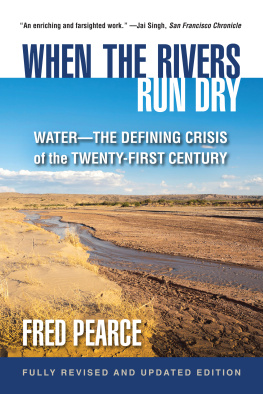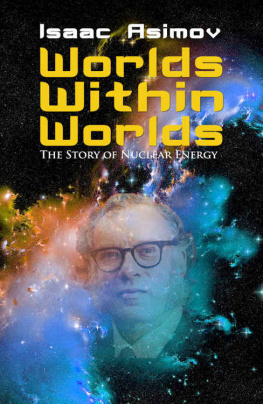Contents
Pagebreaks of the print version
Guide
ALSO BY FRED PEARCE
When the Rivers Run Dry:
WaterThe Defining Crisis of the Twenty-First Century
With Speed and Violence:
Why Scientists Fear Tipping Points in Climate Change
Confessions of an Eco-Sinner:
Tracking Down the Sources of My Stuff
The Coming Population Crash
and Our Planets Surprising Future
The Land Grabbers:
The New Fight over Who Owns the Earth
The New Wild:
Why Invasive Species Will Be Natures Salvation

A Note on Units
In the nuclear world, units are a nightmare. There often seems to be a conspiracy to make them as complicated as possible, what with becquerels (and kilo-, mega-, giga-, tera-, and even petabecquerels), rems and rads and sieverts and curies and roentgens and grays and coulombs. What can all these different units be measuring?
Actually, most of the time, they are measuring one of two things. The first is the amount of radioactivity released in an accident, or perhaps present in a given amount of soil or water or air. The second is the radiation dose absorbed by a living organism, such as you. This second can be a bit more complicated because different kinds of radiation (alpha, beta, and gamma) from radioactive materials reach us in different ways. We might receive an external dose just by being in a radioactive environment or an internal dose by breathing in or eating some radioactive material.
Purists may be twitchy about my ignoring measures for absorbed doses and exposure and the like. But I have decided to keep things as simple as possible. I have chosen one unit for radioactivity and one for radiation dose, and ditched the rest of the statistical mumbo jumbo.
For radioactivity I have chosen the curie. This is an old measure, though still widely used. Some scientists prefer the becquerel. But this is such a tiny unit that we swiftly get into giga-, tera-, and peta- land. I hate that. Its like measuring a car journey in inches. There are a staggering thirty-seven billion becquerels in a curie. For most purposes, the curie is much more manageable. So curies it is. Just occasionally, when dealing with concentrations in small amounts, I have used the picocurie, which is a trillionth of a curie.
For radiation doses, I chose the modern measure of what radiologists call the effective dose, which is weighted to reflect the different damage caused by different kinds of radiation. This is the sievert. It is a bit on the big side. A dose of just four sieverts will probably kill you. But the millisievert, a thousandth of a sievert, does good service. So I have used this throughout. Geiger counters will often measure doses in microsieverts per hour. Generally, and where it makes equal sense, I have converted them to millisieverts per year.
As a rule of thumb then, a dose of four thousand millisieverts is usually lethal; and one thousand millisieverts will probably give you radiation burns and perhaps a range of other potentially lethal symptoms known as acute radiation sickness. Below that, one hundred millisieverts is the lowest dose where there is reasonable evidence of a human health effect, such as more cancers in a population. For comparison, around two to three millisieverts is a typical annual dose from natural radiation sources; a mammogram is about the same. One millisievert is reckoned the maximum acceptable annual radiation dose for members of the public from power plants or nonmedical sources.
In other measurements, I have generally used US customary units: feet, pounds, gallons, and so on. I have converted euros, pounds sterling, and other currencies to US dollars. The exchange rate at the time of conversion made a euro worth $1.15 and a pound $1.30. The original units often appear in the end-noted sources.
Introduction
Anthropocene Journey
One sunny morning in September 1957, a line of military trucks drove down a narrow lane beside a lake in the foothills of the Ural Mountains, the chain that divides European Russia from Siberia. They stopped at a tiny village called Satlykovo. Red Army troops began knocking on doors and ordering the few hundred inhabitants to strip off their clothes, put on replacements unloaded from the trucks, and climb aboard. The villagers were being evacuated. They could not take any of their possessions, not even banknotes. As the evacuees bid a hasty goodbye to their worldly goods, the soldiers knocked down their homes to prevent them returning, and shot their cattle and pets.
The troops gave no explanation for the evacuation. They could not sayeven if they knewthat a week before there had been an explosion in radioactive waste tanks at Russias biggest plutonium factory, in the nearby closed city known today as Ozersk. Nor could they say that the strange dark cloud that had descended on Satlykovo hours later contained the deadly fallout from the accident.
The troops could not say any of this because the very existence of the nuclear-weapons complex was a military secret, known only to its fenced-in workers. Nobody outside was supposed to knowever.
Sixty years later, on another bright, sunny morning, I became the first Western journalist to visit Satlykovo since the accident. I drove through a gate still guarded by armed troops and down a long rutted lane. I found the village, but the remains of the seventy-five hastily demolished houses were consumed by vegetation. Nettles were everywhere. The hot, sticky air was thick with giant dragonflies. Across overgrown fields, the lake had plenty of fish, though nobody was allowed to catch them. The encroaching forest along the track harbored elk, wild boar, and foxes. Radioactive it may have been, but a barren wasteland it was not.
So started my journey to discovery the radioactive legacies of the nuclear age, an age I believe and hope is coming to a close. In this book, I explore the weird radioactive badlands created by nuclear accidentssome famous, such as Chernobyl and Fukushima, and some largely unknown, like the area around Satlykovo. I visit places where atomic bombs have been dropped, in the name of science or as acts of war, and where radioactive wolves roam but people fear to tread. I try also to make sense of our many personal and collective responses to the unleashing of the power of the atom, to the sense of foreboding and the all-too-real threat that it could be used to annihilate us all. In many ways this new psychological landscape turns out to be the strangest place of all.

This is a personal journey too. I first became aware of nuclear technology during the Cuban missile crisis of 1962. I was ten years old and preparing to walk to school when my father told me out of the blue that if I saw a mushroom cloud during morning break that day, I should go back into the classroom and hide under my desk. I recall being confused, not least because I didnt quite know what a mushroom cloud looked like. Even so, during break I looked up at the sky for some time, just in case. I still remember the blue sky behind a big tree across the road, and a slight feeling of disappointment when no mushroom cloud appeared.
The realities of the nuclear age were new to everyone then: scary and somewhat secret, even to adults. At that age, I believed that adults knew everything; but about atomic stuff they were as much in awe and ignorance as we children. Growing up in southeast England, I would have been under an invisible radioactive cloud myself. It crossed the country after the fire at the Windscale plutonium plant in 1957. But nobody knew, because the clouds path was a state secret. The nation was told the cloud went out to sea and wasnt very radioactive anyway. That was a lie, a lie told to adults as if they were children.



















